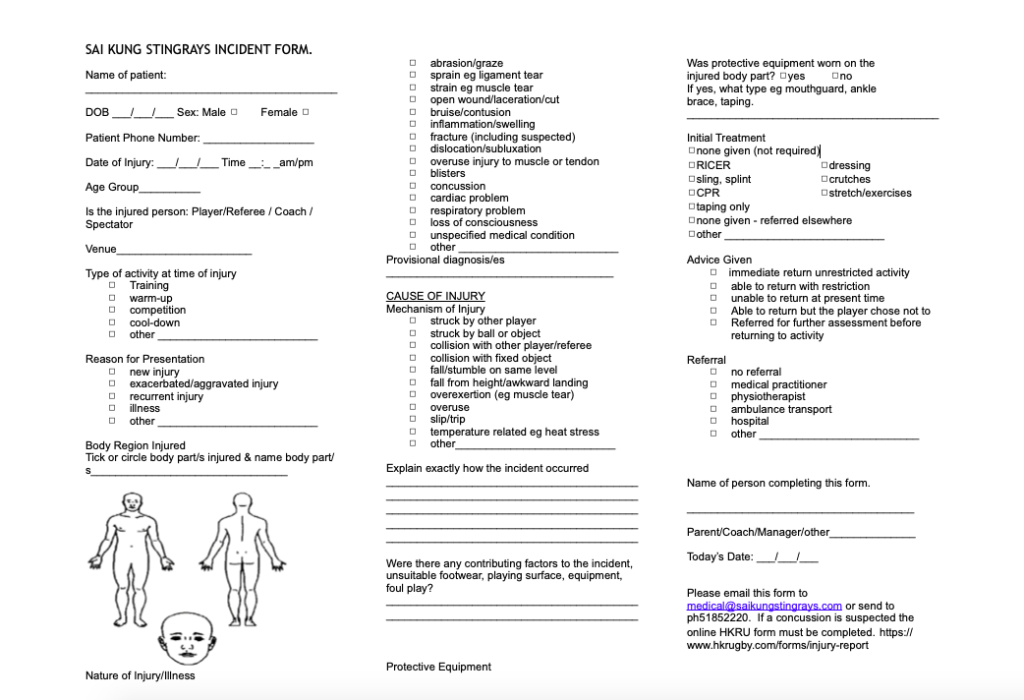RUGBY SAFETY
MEDICAL INFORMATION 2
Safety First!
Rugby in Hong Kong is “A Game for All!”
The Hong Kong Rugby Union offers rugby opportunities for every age and skill level with an emphasis on safety first and foremost. Whilst everyone associated with Hong Kong Rugby wants the players to have fun, we do stress the need for safety in play and in equipment. All youth players MUST wear mouth guards to protect the teeth and, whilst optional, the use of IRB approved headgear and shoulder pads is recommended.
The coaching of youth rugby also involves safety through well-trained play. Teams at various age grades will adopt special rules as they progress in age and ability towards virtually full adult rules for their matches, but coaches and referees are empowered to change some areas of play (e.g. non-contest scrums) if they consider any danger of injury exists.
At all times, players are coached to a suitable standard for safe and enjoyable competition. Our aim at Stingrays is to ensure the children enjoy their rugby in a safe environment.
Adele Brunner is the club’s assigned Medical Officer and she works closely with the Union. We also look to have coaches/parents join the first aid courses that the Union runs. Should you be interested in joining one of these courses then please contact our First Aid and Safety Officer: medical@skstingrays.com
HKRU Concussion Statement
December 2015
HKRU places player welfare above all else in our game. We are aware of the controversies regarding concussion in contact sports. In 2013 we set up a concussion working group comprising medical experts, coaches, referees and players. We are the first rugby union in the world to have introduced a comprehensive, union wide concussion policy including the mandatory removal of all potentially concussed players at all levels from mini rugby to the premiership. We run educational workshops for players, referees, coaches, parents and management staff and screen injured athletes through our medical program.
We do not take concussion lightly and will continue to make decisions in response to the latest available evidence. We believe that decisions about concussion should be made on the basis of evidence not emotion and we will continue to strive to enhance the well-being of all the players who take part in our game.’
Information and resources are available at: www.playerwelfare.worldrugby.org and www.hkrugby.com
Education is the way ahead with concussion. All players, coaches, referees and parents are encouraged to review the Pocket Concussion Recognition Tool. www.thinkfirst.ca/downloads/concussion/concussion-recognition-tool.pdf
Recognise and remove – look out for convulsive, headache, knocked out, nauseous, unsteady, confused dazed and/or dizzy to name but a few. If there is one or more visible clues of suspected concussion as documented on the Pocket Concussion Recognition Tool, the player should be removed from the pitch and not allowed to return to the game.
Concussion “makes no sense”– a concussed player may be confused and they are at increased risk of harm. Do not leave them alone. Do not let them drive.
Call an ambulance or at least insist on same-day medical review if you suspect concussion.
Don’t risk your brain to win a game, Concussion, no discussion, tough nuts walk off.
Heatstroke and Hydration
Throughout August, September and October, the combination of heat and humidity is so intense in Hong Kong that the risk of heat exhaustion and heatstroke for the children at training is very real. Heatstroke can be life threatening and heat exhaustion can progress quickly into this state.
Children are more vulnerable to heatstroke as they don’t create as much perspiration and they produce more heat than adults when they exercise. Parents need to be vigilant through these hot, humid weeks to ensure the children are safe.
It is important to make sure that children are well hydrated before they start training. That means lots of water before they arrive at the stadium as well as during training. FIZZY DRINKS ARE A “NO NO”! If they are wearing headgear it should be removed during the water breaks.
Short socks during the hot and humid training days do help the children to regulate their temperature. Watch to see your child actually drinks properly when the coaches have the water breaks. If you need to leave the stadium for any reason, please assign an adult to watch over your child.
Pouring water over the head or wetting the backs of their necks with ice-cold cloths (a Stingrays tour speciality) really helps to cool them down
If a child complains of a headache or feels dizzy or nauseous they should be taken into the air-conditioning, if it’s available, and cooled by wetting their skin and fanning them. A child who has vomited should never go back onto the pitch.
Please note that Sai Kung Stadium has a sick bay, which is located on the left-hand side in the “tunnel” just before you enter the stadium.
Wound Management
Clean it and Cover it!
Open wounds are a hazard to all. Stop and/or cover all bleeding points. If wounds are covered in soil or grass, wash with large amounts of clean water before covering. This will decrease the chance of the wound becoming infected.
Cover small wounds that are not actively bleeding with clean dry dressings. Wounds that are actively bleeding should be stopped by direct pressure through a clean dressing and then covered. If bleeding continues to soak through the dressings despite further attention, then the player should not continue to play.
Remember to wash excess blood aware from hair or clothing using clean water. Players who are heavily contaminated with blood must not return to play until the blood is removed/ clothing changed.
BEWARE
- Wounds you cannot see the bottom of
- Large wounds or wounds where the edges do not come closely together
- Excessively painful wounds V what else is injured?
- Wounds that will not stop bleeding
These are the wounds that need to be reviewed by an experienced medical practitioner.
First Aiders should protect themselves with gloves and clean dressings before touching a wound.
The IRB’s Rugby Ready is also a good resource for all: www.rugbyready.worldrugby.org.


